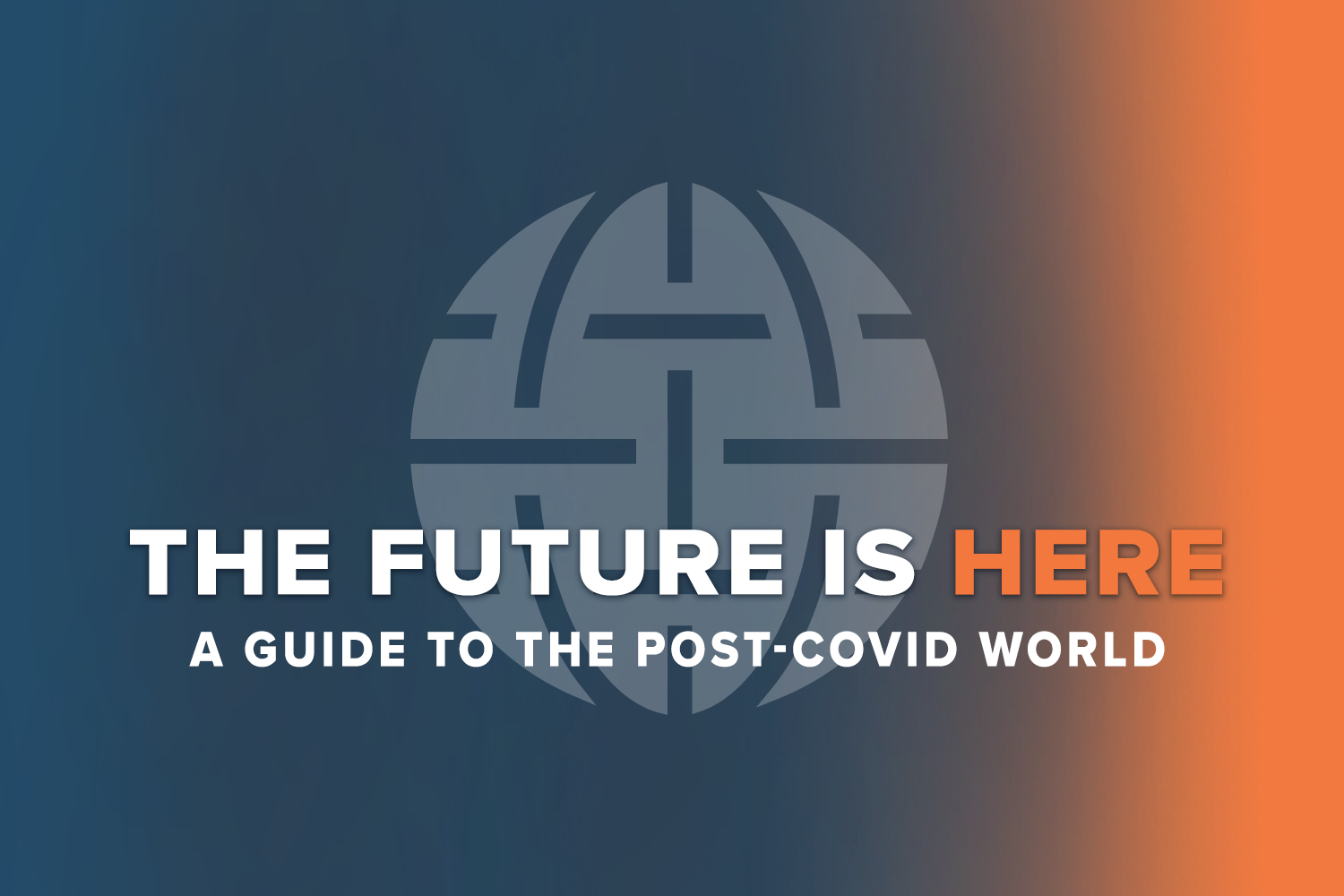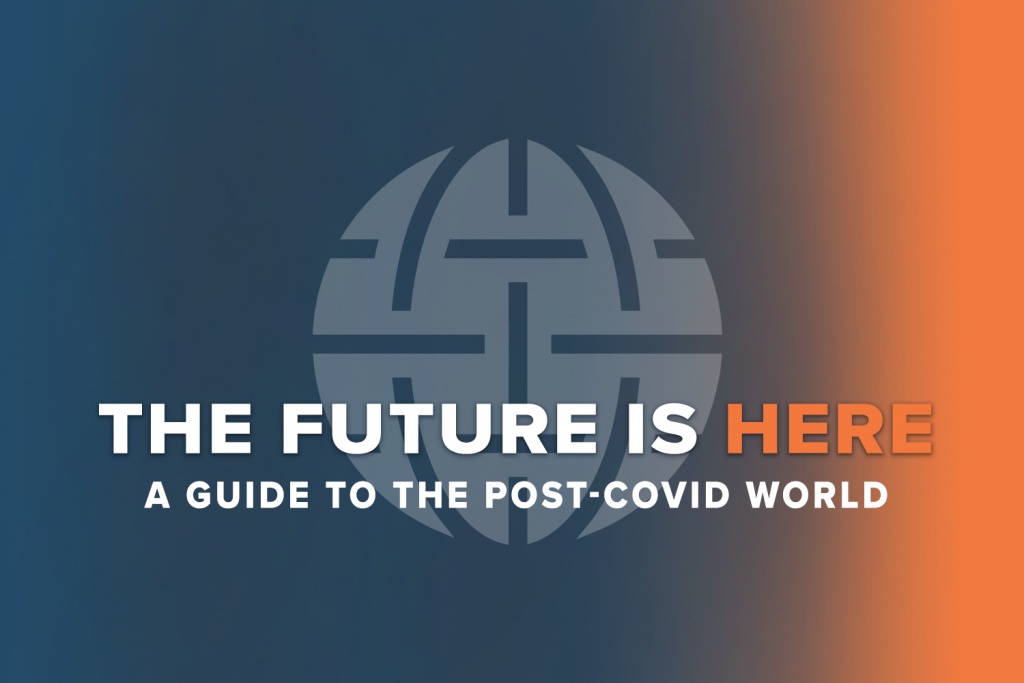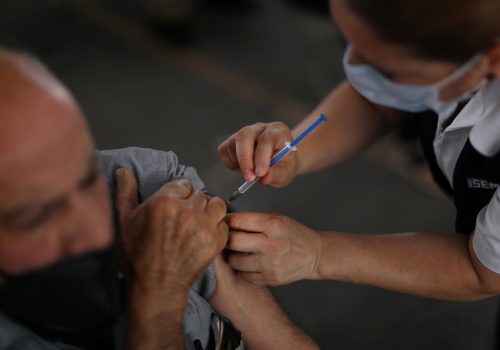The future is here: A guide to the post-COVID world 05/21/2021
Welcome to your guide to where the world is headed during the pandemic era and beyond, from Andrew Marshall. Each week, we’ll bring you the latest and most significant expert insights and international news about how coronavirus is reshaping international affairs. To stay updated each week, sign up to the newsletter here.
Let’s take a spin around the globe, in seven minutes or less.
In top stories this week:
- New York and other US cities are returning to life.
- The United States is increasing vaccine exports (but it could do more).
- Do we face a turnover tsunami at work?
- But first…
The big story
This week’s key theme: Is digital adoption really taking hold?
Welcome to 2025. That’s how far into the future we are.
At least, that’s the thesis of Lloyds Bank in the United Kingdom, looking at the rapid increase in digital adoption during the pandemic.
“In the last 12 months, 1.5 million more people [in the United Kingdom] have started using the Internet, resulting in 95% of people now being online,” writes Stephen Noakes, the bank’s retail transformation managing director. “In 2020, predictive modelling indicated that it would take to 2025 for 58% of the UK to have high digital capability. In 2021, 60% of the UK now have this level of digital capability; we have made five years’ worth of progress in one.”
The title of this newsletter is in part inspired by a famous quote from sci-fi author William Gibson: “The future has arrived—it’s just not evenly distributed yet.” That has long been true of digital adoption. Some of us have been happily playing around with machine learning and Augmented Reality, while others are still trying to work out how to use their phones. The pandemic has nudged that curve.
“We’ve seen two years’ worth of digital transformation in two months,” said Microsoft CEO Satya Nadella last year. And again this spring: “Over a year into the pandemic, digital adoption curves aren’t slowing down. They’re accelerating.”
“There is no going back to the past that existed before the pandemic,” said the Economist in November. “Instead, COVID-19 has propelled the world into a very different future.”
In some areas, that seems certain. In financial services, the last year has only accelerated change. “By May, more than 45 percent of Americans had changed the way they dealt with their bank, a survey of 1,000 people by consultancy FIS found,” according to the Financial Times. In retail, “global digital revenue grew by 58% YoY in Q1 with two countries experiencing triple digit growth, the Netherlands (108%) and Canada (111%),” said Forbes magazine, quoting a study by Salesforce.
But perhaps the techno-optimism is overblown. UBS analyst Karl Keirstead found far more modest IT growth than most analysts expected, reported Barrons, a financial publication.
“The dream of digital acceleration is meeting the reality of a still-prevalent focus on cost savings resulting from the massive economic hit that organizations absorbed in 2020,” Keirstead wrote.
There are some obvious areas—collaboration tools, use of the cloud, and online shopping—where change has been rapid; in other areas, it is a struggle.
Around the world, many simply lack the resources, education, or technology to participate in this tech shift, especially in the global south. For the poor and disadvantaged, the techno-optimism was never realistic in the first place.
Even for those who do have the resources and the need, going digital isn’t always easy, and that has created a new industry. Nilanjan Adhya, chief digital officer for IBM Cognitive, turned to digital adoption platforms, a technology that eases the path of change, to help him persuade new users to get started with challenging products, according to Information Week. “When you are able to get users past that hurdle, they become more productive and we retain them at much higher rates,” Adhya said.
Change is hard. A startling survey from Boston Consulting Group shows that 70 percent of all digital transformation initiatives do not reach their goals. Of the $1.3 trillion that was spent on transformation in 2019, it was estimated that $900 billion was wasted. Digital adoption platforms like Walkme and Whatfix aim to help make that process less painful.
Just as we can spring into the future, so we can fall back. The dot-com crash of 2000-2001 probably set back innovation, for example. In 2001, after Internet adoption plateaued, the Wall Street Journal outlined a scenario where it took another thirty years for the internet to match television’s 98 percent US penetration. Today, 93 percent of American adults use the internet; we still aren’t there.
As people go back into the office this year, they may well discover the future is waiting for them; but it may just be the dead houseplants and dirty coffee mugs they left there in March 2020. The future is not evenly distributed, but neither, it turns out, is the past.
Subscribe to The future is here: A guide to the post-COVID world
Sign up for a weekly roundup of top expert insights and international news about how coronavirus is reshaping international affairs.

The world in brief
Insights from across the planet, in ten bullets or fewer
- New York returns to life: A slow reopening is underway across the United States and many European countries. The New York Times ran a beautifully written short piece by local reporter Michael Wilson on what that feels like in the city. “From the Bronx to Staten Island, Chinatown to Fifth Avenue, in Michelin-starred restaurants and humble corner diners, hardware stores and funeral homes, New York moved gingerly toward reopening on Wednesday,” he wrote.
- India’s death toll rises: While one part of the world is reopening, India continues to suffer a dreadful daily toll. The country reported more deaths from coronavirus in one day than any other nation at any time, with 4,529 deaths on Wednesday. The numbers are almost certainly undercounts, according to the Associated Press. “As families upon families fall prey to the virus, this time around we are also seeing another disturbing trend: people losing more than one member in their household to COVID,” wrote the Times of India in a harrowing piece.
- Children are getting vaccinated: The topic of children and vaccination is fraught. Vaccines have been made available to younger teenagers in the United States, and at least 600,000 children, ages twelve to fifteen, have received their first dose, said Dr. Rochelle Walensky, director of the US Centers for Disease Control and Prevention. Dr. Anthony Fauci also said that younger children will probably get access to vaccinations by the end of this year or the beginning of 2022. Some people argue that vaccinating children is critical to fully reopening schools. Other experts argue that it would be better to export the vaccines since children are at lower risk than adults.
- The United States announced that it would increase vaccine exports: In addition to sixty million doses of the AstraZeneca vaccine, President Joe Biden said he will ship twenty million doses of the Moderna, Pfizer-BioNTech, and Johnson & Johnson vaccines overseas. A substantial portion of those will be funneled through the World Health Organization’s COVAX scheme, said US State Department Coordinator for Global COVID Response and Health Security Gayle Smith at a news conference. India’s Serum Institute said that in response to the country’s spiraling level of infections it will suspend all exports until around the end of the year, “dealing a major blow to the global initiative to share jabs with poorer nations,” said the South China Morning Post. And while most countries are a long way from vaccinating their populations, “some are already making plans to deliver millions of booster shots into arms later this year,” the Wall Street Journal reported.
- Heading back to work, probably: Most companies in the United States and Europe are now planning a return to work; fewer know what they will actually do. A survey by consulting company McKinsey found that 90 percent of employers will combine remote and on-site work, but 68 percent lack a detailed plan to implement the vision. That may be linked to the fact that many workers aren’t clear about what they want to do either. “There’s a wild card in the push to return to pre-pandemic life: Many workers don’t want to go back to the jobs they once had,” reports the Associated Press. “As the economic recovery continues and companies craft their return-to-work plans, experts and surveys show businesses need to be prepared for another potential disruption: a potential surge in turnover,” writes the Cleveland Business Journal, calling it a potential “turnover tsunami.”
The inside scoop
Insights from the Atlantic Council
Andrew Marshall is the Vice President of Communications for the Atlantic Council. He leads the Council’s media, digital, and editorial efforts, and coordinates the way the Council talks with its key communities.


